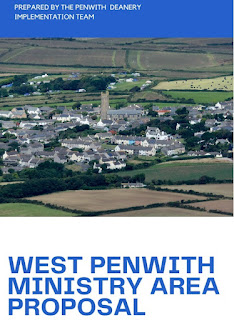REVAMPED DEANERY PROPOSALS ACKNOWLEDGE NEED FOR NAMED PAID PARISH PRIESTS IN PARISHES
At the meeting - the latest step in the Diocese of Truro’s controversial On The Way restructuring plans - there will be a vote on hotly contested clergy numbers. Thrashing out a plan for the Land’s End peninsula has been beset with problems due to a high number of vacancies as well as recruitment difficulties.
The situation is complex: Penzance has some of the highest levels of poverty in Cornwall and the area has some of the county’s most historic churches and fiercely loyal church communities. In the spotlight now: the Diocese’s commitment to increasing number of priests in post and its stated priority ‘to answer the ministry needs of the deanery'.
The latest West Penwith Area Ministry Proposal - click here to read - includes the welcome recognition: “… it is important to retain a local presence for stipendiary ministry and for congregations/local communities to have a named presence.” This is an important - and long overdue - shift in emphasis compared to other deanery plans.
The paper has been circulated to all Parochial Church Councils (PCCs) ahead of the Deanery Synod. Church goers are encouraged to make their views known and ask for information.
Developed and drawn up by the Deanery Implementation Team (DIT), it envisages eight stipendiary priests in Penwith as a whole (West Penwith and East Penwith), compared to 5.5 previously. In west Penwith (the Land’s End peninsular) stipendiary provision will be increased from 2.5 priests plus one House for Duty to four stipendiary posts.
Two options are presented – to be discussed at the Synod on 23 May 2024.
OPTION 1. Four clusters in west Penwith, each with a named dedicated paid priest
a. Penlee with Sancreed
b. Madron, Gulval, Towednack and Zennor
c. Land’s End
d. Penwith Pilgrims (St Just, Pendeen and Morvah). A priest, Rev Karsten Wedgewood, is already in post.
The other priests are likely to be based in Madron, St Buryan and Penzance/Paul (where there are vicarages).
OPTION 2. Three clusters with ‘one resourcing area priest’ i.e. someone who will travel around to parishes in the area when needed
a. Penlee with Sancreed
b. Madron, Gulval, Towednack and Zennor
c. Penwith Pilgrims with Land’s End
It warned, however, that an ‘area priest’ – which would be in effect a free-floating post -could result in an individual being spread too thinly across the entire ministry area.
Interim Rural Dean Nick Widdows told Save the Parish Cornwall he believed that the rise to eight stipendiary priests in Penwith Deanery overall is a considerable improvement. He said a mega benefice (like the 23-church model in Kerrier) was not on the cards. In contrast, the proposed new model suggests far smaller – and manageable - groupings of churches.
“People will still have a relationship with a parish priest,” he said. “This feels like a reasonable compromise, given the constraints and financial resources available in the diocese. In the current context, this feels good. The proposed new posts are an exciting opportunity to work in a beautiful part of the country.”
Some churches in west Penwith, however, which have not had a dedicated vicar for years, feel sidelined. And the departure of popular local clergy Rev Andrew Yates (Paul) and Rev Sian Yates (Penzance) in Penlee Cluster – whose ministry had a high profile in the county and beyond - leave two very large gaps to fill. Penlee Cluster will now have only one priest covering Penzance, serving an area of increasing poverty.
In Zennor, Towednack and Sancreed – all churches with strong identities and hard-working teams of stalwarts keeping buildings repaired and services running - people feel that at best they have been ignored, at worst sidelined. They remain unsure how they will ‘fit’ into the proposals.
“The avalanche of useless paperwork, lack of transparency, and the rampant inefficiency in the diocese is in turn frustrating, maddening and objectionable,” said one churchgoer.
Unfortunately, despite a stated intention from the DIT to publicise its discussions – minuted here – there has been virtually no information about these plans in the deanery's monthly newsletters produced by its new paid administrator.
Others question why there is a commitment to lay workers (Children and Family Officers funded by the Church Commissioners’ Lowest Income Community Fund) and a ‘Kingdom Enterprise Officer’ rather than a 100% focus on priests in parishes. The Kingdom and Enterprise Officer was described in a previous proposal as "developing pilgrimage trails, promoting heritage through publicity and merchandise.”
“I submit that administering Holy Communion directly to congregations is more important than promoting heritage through merchandise,” said one Save The Parish supporter.
Rev Widdows, who believes this is truly the best that can be negotiated, urges those who have reservations to talk to him. “I’m ready to talk and meet anyone who wants to discuss it,” he said.


.png)